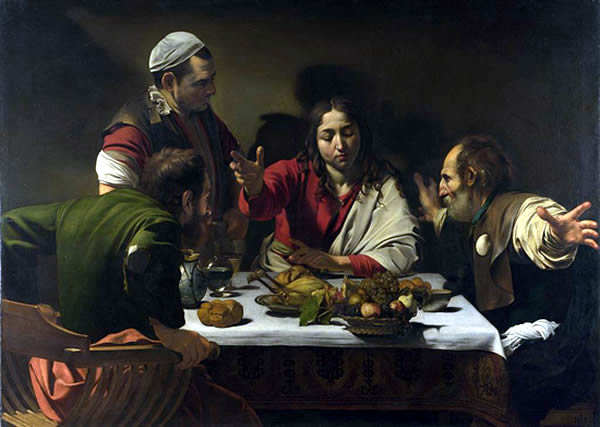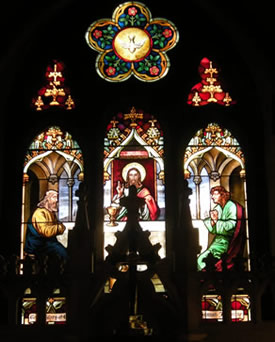
The picture above represents the final segment in the well-known New Testament story after Jesus' resurrection known as "The Road to Emmaus" story. The picture depicts the exact moment when the two travelers recognize that their so-far-unknown traveling companion is Jesus.
The full Road to Emmaus story is found in the gospel of Luke 24:13 - 35. (Mark also records a very brief, similar story — not naming the destination as Emmaus — in a few verses scholars do not find in the earliest manuscripts: Mark 16:12-13.) If you're not familiar with the story or don't recall the details, I suggest you take time to read the full Luke account. If you don't want to take the time now, here is my Cliff Notes summary:
Later in the day of Jesus' resurrection, two disciples were traveling to a village called Emmaus (possibly their hometown), which was about seven miles from Jerusalem. Scholars are not sure of the specific location of Emmaus in the story; several have been suggested, with four different sites thought to be legitimate possibilities. One of the disciples is named Cleopas; the other is not identified. Although called disciples, they were not obviously part of The Twelve we recognize. They may have been in an outer circle as many followers were called disciples.
Whatever the details, these two were walking and talking about all that had happened the last few days. The "trial" and Crucifixion of the One they had followed, and now these stories that some folks had seen the risen Jesus. It was probably a troubled walk, not knowing what to make of events and even what to believe. As they walk and talk, another traveler joins them: Jesus! However, they do not recognize the man as Jesus. There is speculation why these disciples who knew Jesus did not recognize him. Were they so grief-stricken that their eyes couldn't see reality? Was Jesus so clothed that his face was hidden? Or did Jesus in some super-natural way prevent them from seeing? Luke suggests the latter in verse 16, "but they were kept from recognizing him."
Speculation aside, Jesus asks the two what they are discussing. They are amazed that their new companion is clueless about all these stories of Jesus of Nazareth. They summarize the recent events. Then Jesus quotes various prophets and explains what the scripture says about him (Jesus). They are still unaware of who their companion is. As they approach their hometown, Jesus says he is going further, but the two urge him to stay with them as it is almost supper-time.
Then during supper, Jesus takes the bread, breaks it, and gives it to them. At that instant, their eyes are opened and they recognize their companion. And then Jesus simply disappears from their sight. Probably somewhat in shock, they think back a few hours: "Were not our hearts burning within us while he talked with us on the road and opened the scriptures to us?" (Luke 24:32). Then they get up and return to Jerusalem, and share their story. They relate that they did not recognize Jesus until "he broke the bread."
Can you imagine their shock
when they "see" Jesus? Caravaggio's painting above captures this shock so well! (Fr James Martin, in Jesus: A Pilgrimage says that the look of
the disciples is his "favorite depiction of surprise in the history of art."Martin's full description
is this:
"A beautiful painting by Caravaggio, 'The Supper at Emmaus,' completed in 1601, depicts this precise moment
(when they recognize Jesus). Jesus sits at a rough-hewn table between the two disciples. Poised over the table top,
Jesus extends his right hand, having pronounced the blessing. The disciple on the right, on whose garment is pinned a
scallop shell – the symbol of the pilgrim – is stunned by the sudden revelation of the stranger's identify.
He flings his arms wide as he stares at Jesus. And, in my favorite depiction of surprise in the history of art, the
other disciple grips tightly the arms of his chair. He seems ready to spring from his seat entirely, unable to
control himself, or perhaps he is hanging on for dear life." Taken from Jesus: A Pilgrimage; James Martin, SJ, page 427.
© 2014; HarperCollins Publisher.) Have you ever been shocked when you think you have just seen Jesus?
Do you remember a moment when God seemed to open your eyes to see the divine? Maybe your prayer is often like mine:
"Open my eyes, Lord, I want to see Jesus."
And the obvious question for us is: "Would we recognize Jesus when we see him?" Or are we like those two on the way to Emmaus; sharing the road but our eyes closed to seeing that Jesus is our traveling companion?
Surfing the Internet to find a music video for the hymn, Open Our Eyes, Lord; We Want to See Jesus, many of the versions had the beautiful words and music with very pastoral or majestic-mountain scenes for rotating backgrounds. I thought of how often we retreat to such places to have our eyes opened. But, I wonder. The spot of solitude beside the rippling mountain stream is an ideal place to commune with our God, to be awe-struck with the creator's handiwork, to ponder the universe and our place in it. But, are we "seeing" God and Jesus?

Window behind altar in chapel at my church: Church of the Good Samaritan, Paoli, PA
Perhaps a problem (in trying to see God) is that we are "trying to". Maybe Jesus shows up, or we see him, when we least expect it. Perhaps our "trying" keeps our eyes closed. Maybe it is when we are just going about our business that we see Jesus. Maybe, it is in the evening when we reflect on our day that our eyes are opened and we realize that in some almost-forgotten event that we did see Jesus.
Maybe we don't see Jesus because of our expectations of what he should look or be like. Perhaps the Emmaus Road travelers didn't recognize Jesus because he looked like them ... just another tired, dust-covered traveler. Maybe he was that harried-looking guy across the aisle on the commuter train coming home last evening. You didn't recognize him, until he smiled at the old guy looking for a seat and moved his briefcase from the spot beside him that he was protecting for a bit of privacy.
Maybe we don't see Jesus because our preconceived biases make us know that we will not see him in THAT place. Maybe we close our own eyes to seeing Jesus in that part of town. Do our expectations include that maybe he is speaking in a language other than English? We might expect to see him walking out of a church with a cross on the steeple. Would we even pause to consider that he might be one of those bearded guys leaving the local synagogue? (After all, Jesus was a Jew!)
Maybe we don't see Jesus because we are focusing on finding support for our fear that our Christian faith is being pushed aside or given a backseat by secular society. Perhaps, at Christmas, we miss seeing evidence of the Incarnation because we are looking for evidence of something like a "War on Christmas." Are we in a posture to want to see God ... or are we wanting to see something else?
And perhaps we don't recognize it is really Jesus when we do see him because what he is saying or doing doesn't fit into our preconceived understanding of him. Are we prepared to perhaps be as shocked as the Emmaus guy above holding on to his chair when we realize what this Jesus is saying? Are our minds — let alone our eyes — open enough to consider the shocking message might really be that of Jesus? Are we like the Pharisees, unable to see who Jesus really is because his teachings and actions don't fit with what we "know" the Christ should be?
A few weeks ago, my wife Rose came home from a long evening registering folks who had come to our church for its weekly distribution from our Food Closet. "We were so busy!" she said, "Welcomed and served 54 families." (It's always eye-opening to me to recognize the need out there, even in one of the wealthiest counties in the United State.) She related one special, but fairly typical, story.
One registrant in the atrium waiting area was obviously nervous when her number was called. This was her first time at our Food Closet, so the registration process was longer and she had never done anything like this before. Rose helped her with the papers — the task a bit uncomfortable because the lady reeked of smoke. After registration, the newcomer thanked her, and went with a helper to get her food.
A few minutes later, the woman came returned to the atrium followed by a Helping Hands volunteer with her cart ready to take the food out to her ride. She stopped, however, and walked over to Rose. They embraced. And the woman cried a bit. "Thank you so much for what you all do here," she said. "I was so nervous -- my husband and I never thought we'd ever be in a position to have to do this," she cried. "And you made me feel so welcome and everyone made me feel comfortable. Thank you!" And she went out in the dark to her ride ... with her food. When Rose related the story to me, Rose laughed, adding, "And when we hugged, I didn't smell the smoke."
I don't know all that the two women in this brief story actually saw or experienced or what they made of it. But in my hearing the story, I knew that I had seen God.
Maybe our prayer needn't be, "Open our eyes; we want to see Jesus." Maybe it should be even more brief: "Open Our Eyes."
Matthew's gospel (11:2-5) includes a story, which perhaps says all we need to know if we want to see Jesus: John the Baptist is in prison (before being beheaded). He is hopeful that Jesus, the one he had baptized earlier, is really "the One who is to come" (The Messiah). John directs some of his followers to go to Jesus and ask him. Jesus tells them, "Go back and report to John what you hear and see: The blind receive sight, the lame walk, those who have leprosy are cleansed, the deaf hear, the dead are raised, and the good news is proclaimed to the poor."
Resources Related To this Reflection
 Meditation on the Emmaus Road
Meditation on the Emmaus RoadAn excerpt from Fr James Martin's Jesus: A Pilgrimage as referenced above.
Open Our Eyes Lord





